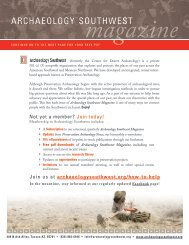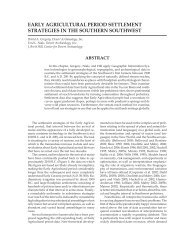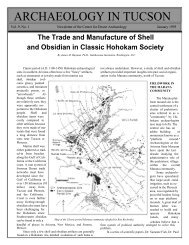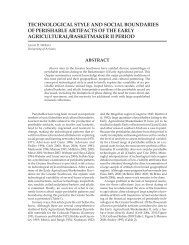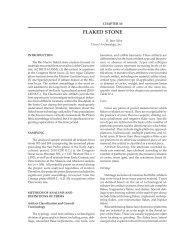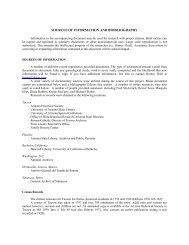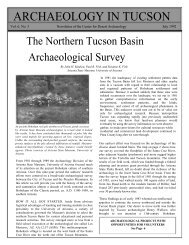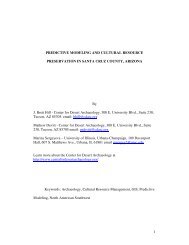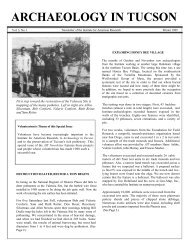Summer 2010 - Archaeology Southwest
Summer 2010 - Archaeology Southwest
Summer 2010 - Archaeology Southwest
You also want an ePaper? Increase the reach of your titles
YUMPU automatically turns print PDFs into web optimized ePapers that Google loves.
Preservation<br />
<strong>Archaeology</strong><br />
NEWS<br />
Preserving the Places of Our Shared Past <strong>Summer</strong> <strong>2010</strong><br />
Tribute<br />
Remembering Friends<br />
Dwight Riggs<br />
Image courtesy of Mike Gleeson<br />
The life of long-time Center friend<br />
Dwight Riggs was celebrated by his<br />
friends and family on May 2, <strong>2010</strong>. After<br />
joining the Center for Desert <strong>Archaeology</strong><br />
in 1995, Dwight could be found at<br />
every Center event at which books were<br />
sold. His infectious<br />
enthusiasm, unique<br />
sense of humor, dedication<br />
to the Arizona<br />
Site Steward program,<br />
and willingness to<br />
lend immediate assistance<br />
in many forms<br />
are well-remembered<br />
by many. One site<br />
steward fondly recalls,<br />
“He carried a backpack<br />
that none of us<br />
could pick up! It was<br />
full of ‘things,’ just<br />
in case someone got<br />
hurt, was hungry, or<br />
needed something to<br />
read.”<br />
Dwight’s brother Douglas Riggs writes<br />
that Dwight grew up in Rhode Island,<br />
studied library science, took a degree<br />
at Colby College in Maine, and served<br />
as an officer in the U.S. Coast Guard.<br />
Friend and fellow site steward Mike<br />
Gleeson notes that Dwight’s involvement<br />
in archaeology began while he was<br />
volunteering with the National Forest<br />
Service in the Seattle area.<br />
One of the first members of our<br />
Legacy Circle—the Center’s planned<br />
giving program—Dwight designated<br />
a generous bequest that included his<br />
archaeological library and two vehicles.<br />
The lovingly collected volumes signifi-<br />
Top: Dwight Riggs at the Cerro Prieto<br />
site, Arizona. Right: Dave Gregory<br />
(left) and Emil (“Doc”) Haury.<br />
cantly expand our research library, to<br />
the benefit of staff and members alike.<br />
Books that are not added to our library<br />
will be sold at a special sale later this<br />
year. Proceeds will benefit the Center.<br />
For more information on planned giving,<br />
contact Linda Pierce at lpierce@cdarc.org or<br />
(520) 882-6946, ext. 23.<br />
David A. Gregory<br />
Archaeologist David A. Gregory passed<br />
away in Show Low, Arizona, on the evening<br />
of June 13, <strong>2010</strong>. Dave had been<br />
working from his home in Pinetop for<br />
the Center for Desert <strong>Archaeology</strong> and<br />
Desert <strong>Archaeology</strong>, Inc.<br />
Dave’s remarkable skills as a field<br />
archaeologist, his intelligence, and his<br />
broad mastery of the archaeological literature<br />
were applied with his signature<br />
intensity throughout his career. Arizona<br />
State Museum Curator Mike Jacobs comments:<br />
“I have admired immensely his<br />
work, not only at Las Colinas, but especially<br />
his more recent work on Archaic<br />
and Early Agricultural period sites here<br />
in Tucson and on the Zuni Origins book<br />
with Dave Wilcox. His collected body<br />
of work includes some really significant<br />
contributions that will stand as a tribute<br />
to him for years to come.” Archaeologist<br />
Douglas Craig of Northland Research,<br />
Inc., sums things up in a grand, straightforward<br />
way: “I consider Dave to have<br />
been one of the great southwestern<br />
archaeologists of our generation.”<br />
In order to further Dave’s already<br />
considerable legacy, the Center for<br />
Desert <strong>Archaeology</strong> has established<br />
the David A. Gregory<br />
Research Fund, a permanent,<br />
endowed fund.<br />
Plans for a memorial<br />
service and celebration<br />
of Dave’s remarkable life<br />
are underway. They will<br />
be announced when they<br />
are final.<br />
Contributions to the<br />
David A. Gregory Research<br />
Fund are tax-deductible.<br />
Donations may be mailed to<br />
the Center for Desert <strong>Archaeology</strong><br />
at 300 N. Ash Alley,<br />
Tucson, Arizona, 85701,<br />
or made online through the<br />
Donate Now link at<br />
www.cdarc.org/how-to-help/<br />
ensure-our-success/.<br />
Image courtesy of Patricia Crown<br />
Support Our Mission<br />
Not yet a member of the Center<br />
for Desert <strong>Archaeology</strong>? Join today!<br />
Annual memberships begin at $25.00.<br />
Benefits include our quarterly magazine,<br />
<strong>Archaeology</strong> <strong>Southwest</strong>. Current members,<br />
why not give a gift membership to someone<br />
who shares your interest in the past?<br />
More information is available at www.<br />
cdarc.org/how-to-help/become-a-member/.<br />
Preservation <strong>Archaeology</strong> News • <strong>Summer</strong> <strong>2010</strong> page 1
Center for Desert <strong>Archaeology</strong><br />
300 N. Ash Alley<br />
Tucson, AZ 85701<br />
(520) 882-6946<br />
(520) 882-6948 (fax)<br />
center@cdarc.org<br />
www.cdarc.org<br />
Board of Directors<br />
Al Arpad<br />
Peter Boyle<br />
Demion Clinco<br />
Jeffrey S. Dean<br />
William H. Doelle [ext. 17]<br />
Diana Hadley<br />
Bernard Siquieros<br />
Benjamin Smith<br />
Donna Tang<br />
Advisory Board<br />
Hester Davis<br />
Don Fowler<br />
William D. Lipe<br />
Margaret Nelson<br />
William J. Robinson<br />
James Snead<br />
Elisa Villalpando<br />
Staff<br />
Jeffery J. Clark, Ph.D., Preservation<br />
Archaeologist [ext. 22]<br />
Jacquie M. Dale, M.A., Preservation<br />
Archaeologist<br />
Mathew Devitt, M.A., Preservation<br />
Archaeologist and Digital Media Specialist<br />
[ext. 12]<br />
Katherine Dungan, M.A., Research Assistant<br />
Douglas W. Gann, Ph.D., Preservation<br />
Archaeologist and Digital Media Specialist<br />
[ext. 12]<br />
Deborah L. Huntley, Ph.D., Preservation<br />
Archaeologist [ext. 24]<br />
Rob Jones, M.A., Preservation Fellow [ext. 13]<br />
Andy Laurenzi, M.S., Field Representative<br />
[ext. 14]<br />
Debra L. Lee, Office Manager [ext. 10]<br />
Matthew Pailes, B.A., Preservation<br />
Archaeologist<br />
Linda J. Pierce, M.A., Deputy Director [ext.<br />
23]<br />
Paul F. Reed, M.A., Preservation Archaeologist<br />
Kate Sarther Gann, M.A., Membership<br />
Coordinator [ext. 16]<br />
Tobi Taylor, M.A., Content Editor, <strong>Archaeology</strong><br />
<strong>Southwest</strong><br />
James M. Vint, M.A., Preservation Fellow<br />
Aaron Wright, M.A., Preservation Fellow [ext.<br />
28]<br />
Research Associates<br />
Richard Flint, Ph.D.<br />
Shirley Cushing Flint, M.A.<br />
J. Brett Hill, Ph.D.<br />
Patrick D. Lyons, Ph.D.<br />
Become Acquainted<br />
Jeff Dean<br />
Jeffrey S. Dean is Professor Emeritus in the Laboratory<br />
of Tree-Ring Research at the University of<br />
Arizona. His research interests include dendrochronology,<br />
the archaeology of the southern Colorado<br />
Plateau, Navajo ethnoarchaeology, paleoenvironmental<br />
reconstruction, and human-environment<br />
interaction. Dr. Dean joined the Center’s<br />
board as a member-at-large this past spring.<br />
How did you come to be a <strong>Southwest</strong>ern archaeologist?<br />
How were you introduced to dendrochronology?<br />
One semester in the<br />
mechanical engineering<br />
program at the<br />
University of Idaho<br />
persuaded me that I<br />
was not cut out for a<br />
career in engineering.<br />
Guided by a long-standing<br />
interest in past<br />
cultures, stimulated by<br />
books on the classical<br />
Mediterranean civilizations,<br />
my quest for a<br />
Jeff Dean<br />
more congenial course<br />
of study inevitably led to archaeology.<br />
Regrettably, the University of Idaho at that<br />
time did not offer a suitable degree program.<br />
A search for the cheapest university in the western<br />
U.S. that taught archaeology identified the<br />
University of Arizona (UA), where I enrolled as<br />
a sophomore. Interaction with the outstanding<br />
faculty (including Pat Culbert, Ed Dozier, Harry<br />
Getty, Emil Haury, Fred Hulse, Bill Longacre,<br />
Ned Spicer, Clara Lee Tanner, and Ray Thompson)<br />
and students of the Anthropology Department,<br />
a summer at the UA archaeological field<br />
school at Points of Pines, and my subsequent<br />
introduction to the Colorado Plateau turned me<br />
into a <strong>Southwest</strong>ern archaeologist.<br />
In the second semester of my senior year, I<br />
took Bryant Bannister’s course, “Tree-Ring Dating<br />
for Archaeologists.” I discovered an aptitude<br />
for tree-ring dating and acquired an appreciation<br />
for the incredible potential of dendrochronology<br />
for addressing important archaeological and<br />
anthopological questions. Bannister’s contacts<br />
with the National Park Service led directly to my<br />
dendroarchaeological research at Betatakin and<br />
Kiet Siel (Navajo National Monument) in which I<br />
attempted to exploit some of this potential.<br />
As a board member and an academic professional,<br />
what are some new directions you’d like<br />
the Center to explore? What are some of the<br />
most successful programs we should continue or<br />
strengthen?<br />
The Center is justly celebrated for its extensive<br />
research activities, which range across the <strong>Southwest</strong>.<br />
Included in this work are archival efforts<br />
such as the coalescent communities digital database<br />
and the completion of reports on the Davis<br />
Ranch site, which was excavated a half century<br />
ago by the Amerind Foundation. Equally laudable<br />
is the Center’s commitment to conservation<br />
and preservation, as exemplified by work in the<br />
San Pedro Valley and at Salmon Ruin. Finally,<br />
the Center’s public outreach efforts benefit both<br />
the archaeological profession and non-professionals.<br />
The interested public gains an excellent<br />
appreciation for cutting-edge<br />
archaeology in the <strong>Southwest</strong>.<br />
Clearly, efforts such as these<br />
should be continued and<br />
expanded whenever possible.<br />
Funding remains a perennial<br />
issue, however, and the development<br />
of novel fund-raising activities<br />
should be a priority. As a<br />
new board member, I agree that<br />
we should continue to devise<br />
ways of offering the public additional<br />
opportunities to contribute<br />
to the Center, and continue<br />
vigorous pursuit of external<br />
funding in cooperation with other institutions.<br />
Everyone associated with the Center has favorite<br />
places in the <strong>Southwest</strong>—what are yours? What is<br />
your connection to them?<br />
Coming to UA and subsequent work with the<br />
Museum of Northern Arizona and the National<br />
Park Service introduced me to a profound influence<br />
on my professional life—the Colorado Plateau.<br />
The vast majority of my work in archaeology<br />
and dendrochronology has taken place in this<br />
region of awe-inspiring beauty, mind-boggling<br />
environmental diversity, and unmatched anthropological<br />
and archaeological riches. I find the<br />
Plateau as a whole endlessly fascinating, but a few<br />
favorite places, in no particular order, are Tsegi<br />
Canyon, Black Mesa, Long House Valley, Navajo<br />
Mountain and the Rainbow Plateau, Largo and<br />
Gobernador Canyons, Canyon de Chelly, Mesa<br />
Verde, and Chaco Canyon.<br />
To read more about Dr. Dean’s work, check out his<br />
page at the Laboratory of Tree-Ring Research: www.<br />
ltrr.arizona.edu/people/3.<br />
Preservation <strong>Archaeology</strong> News • <strong>Summer</strong> <strong>2010</strong> page 2
Participate<br />
Events and<br />
Opportunities<br />
• Be sure to stop by the Center’s<br />
booth and say hello at this year’s Pecos<br />
Conference, August 12–15. www.swanet.<br />
org/<strong>2010</strong>_pecos_conference/<br />
• The third season of <strong>Archaeology</strong><br />
Café kicks off at 6:00 p.m. on Tuesday,<br />
September 7, with a presentation by<br />
archaeologists from William Self Associates,<br />
Inc. The panel will discuss 2,500<br />
Years in the Marsh: The Prehistory of the<br />
Marsh Station Road Site, Cienega Creek,<br />
Southeastern Arizona. We meet on the first<br />
Tuesdays of each month from September–May<br />
at Casa Vicente restaurant, 375<br />
S. Stone Avenue, Tucson. Visit www.cdarc.<br />
org for more information.<br />
• You’ll also want to stay tuned to<br />
our website for information on our very<br />
special holiday book sale. Scheduled<br />
for December,<br />
this year’s sale<br />
promises savings<br />
and surprises.<br />
We’ll post details<br />
as they become<br />
available.<br />
• Distinctive,<br />
thoughtfully<br />
renovated office<br />
suites are now<br />
available in the<br />
Bates Mansion<br />
portion of our<br />
historic building<br />
complex<br />
in downtown<br />
Tucson. For<br />
information,<br />
contact manager<br />
Susan French of Prudent Preservation<br />
Partners, LLC, at (520) 907-7325.<br />
Douglas Craig of Northland Research, Inc., shared an overview of the Casa<br />
Grande Ruins National Monument and related archaeology with Tea and<br />
<strong>Archaeology</strong> guests on June 27, <strong>2010</strong>. From left to right: Judy Olson, Treasurer<br />
of the newly formed Friends of Casa Grande Ruins; Bill Doelle; Doug Craig;<br />
and Jerry Wilson, Secretary of the Friends of Casa Grande Ruins.<br />
Celebrate!<br />
News We’re Proud to Share<br />
• Congratulations to<br />
our Board Secretary,<br />
Bernard Siqueiros, who<br />
was awarded the Alene<br />
Dunlap Smith and Paul<br />
Smith Award—Tucson-<br />
Pima County Historical<br />
Commission’s highest<br />
honor—at a ceremony on<br />
May 23, <strong>2010</strong>. Bernard was<br />
recognized for his many<br />
accomplishments on the<br />
Tohono O’odham Nation<br />
and his work across the<br />
U.S., educating people<br />
about O’odham heritage.<br />
• Linda Pierce is now<br />
Deputy Director of the<br />
Center. Linda has managed<br />
the Center’s programs<br />
since 1999.<br />
• The Arizona Humanities<br />
Council recently<br />
awarded the Center a grant in support of<br />
our <strong>Archaeology</strong> Café programming. See<br />
Participate for more on our next meeting.<br />
• Field Representative Andy Laurenzi<br />
has been joined by summer employees<br />
Saul Hedquist and Leigh Anne Ellison.<br />
Deb Huntley’s report on another successful field season in Mule Creek, New Mexico,<br />
will be featured in our next issue. The <strong>2010</strong> team, from left to right: Katherine<br />
Dungan (Assistant Project Director), Deborah Huntley (Project Director), Meaghan<br />
Trowbridge (University of Arizona), Jane Carmack (Hendrix College), Lindsey<br />
Romaniello (Hendrix College), Suzanne Eckert (Assistant Professor, Texas A&M<br />
University). Not pictured: Rob Jones.<br />
Saul and Leigh Anne are conducting<br />
site condition assessments on the Tonto<br />
National Forest. Their work will generate<br />
information that enables the Center and<br />
its partners—which include the National<br />
Trust for Historic Preservation—to more<br />
effectively participate in National Forest<br />
planning and decision-making<br />
in the future.<br />
• Cornell University<br />
student and Center intern<br />
Anne Jones is assisting<br />
<strong>Archaeology</strong> <strong>Southwest</strong> content<br />
editor Tobi Taylor this<br />
summer. Special thanks to<br />
Anne for authoring this<br />
issue’s Bookshelf.<br />
• A pat on the back to<br />
Aaron Wright, who recently<br />
finished a draft of his dissertation.<br />
In addition,<br />
Aaron’s question to PBS’<br />
History Detectives regarding<br />
the authenticity of an<br />
inscription in the South<br />
Mountains attributed to<br />
Fray Marcos de Niza will<br />
air this season. Check the<br />
show’s page at www.pbs.org<br />
for information.<br />
• The Center family expands! Kate<br />
and Doug Gann welcomed Eleanor<br />
Frances Gann on March 31, <strong>2010</strong>. Amy<br />
Gail Jones joined Rob Jones and Elizabeth<br />
May on June 22, <strong>2010</strong>. Everyone is<br />
doing well!<br />
Preservation <strong>Archaeology</strong> News • <strong>Summer</strong> <strong>2010</strong> page 3
Non-Profit<br />
Organization<br />
U.S. Postage<br />
PAID<br />
Tucson, AZ<br />
Permit No. 878<br />
300 N. Ash Alley<br />
Tucson, AZ 85701<br />
Save the Date<br />
September 7<br />
<strong>Archaeology</strong> Café<br />
Bookshelf<br />
Familia Elias<br />
The Elias name is one of Tucson’s<br />
oldest, tracing its roots back to the<br />
founding of the original presidio by the<br />
Spaniards. In his self-published book,<br />
Armando C. Elias compiles, in both<br />
Spanish and English, the most up-todate<br />
history of the Elias family. Familia<br />
Elias includes background information<br />
on the Elias family name and origin,<br />
a detailed discussion of Capitan Francisco<br />
Elías González and his brothers<br />
and descendants, as well as an extensive<br />
biography of the descendants of<br />
González’s second and third sons. It<br />
also reveals a previously unrecognized<br />
confusion in the historic record: that<br />
Francisco Elías González de Zayas and<br />
Captain Francisco Elías González were<br />
in fact two different people, and the latter,<br />
not the former, was the ancestor of<br />
the Elias family.<br />
Armando C. Elias has made<br />
several previous contributions<br />
to uncovering the genealogy of<br />
the Elias family. Speaking of his<br />
research, he writes, “I became<br />
aware that many individuals have<br />
thrown away or burned family<br />
records, newspaper clippings,<br />
and other items they considered<br />
unimportant. What a pity! It is my<br />
hope that younger people and<br />
the upcoming generations will<br />
learn to appreciate these things.”<br />
Familia Elias is not only a useful<br />
compilation of information on<br />
one of Tucson’s oldest families,<br />
but also a reminder that every<br />
family’s history is important.<br />
Familia Elias may be purchased from Mr.<br />
Elias for $45.00, plus the cost of postage.<br />
Contact Kate Sarther Gann at kate@cdarc.<br />
org or (520) 882-6946, ext. 16, to be put in<br />
touch with Mr. Elias.<br />
Preservation <strong>Archaeology</strong> News • <strong>Summer</strong> <strong>2010</strong> page 4



